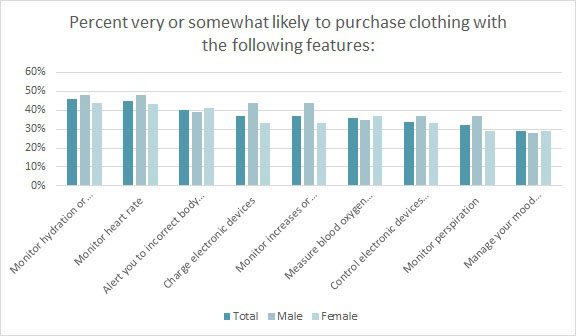Now that the Summer of Superhero Blockbusters has finally concluded, it’s a good time to reflect on the fact that of all the heroes, only Batman is a mere mortal save for his super suit. While the rest of us regular folk don’t necessarily need body armor to get through day-to-day life, science and design are coming together to give clothes a tech boost that consumers might not have even realized they wanted, needed, or could even use. Take, for instance, clothes that can guide wearers through a strange new city, improve workout posture, or turn fabric into computerized displays.[quote]
If it sounds rather far out, keep in mind there was a time in the not too distant past where we didn’t actually rely on a single, mobile device to make calls, take photos, tap into the internet — or chase Pokémon down the street.
Looking to the future, one company is interested in giving people a break from staring at those smartphone screens — via haptic technology in their apparel. Haptics, for those not in the know, is the science of applying touch (tactile) sensation and control to interaction with computer applications, according to WhatIs.com.
“As technology becomes more sophisticated and ubiquitous in everyday life, we believe in going beyond quantified devices and looking at how clothing can interact with the skin to enhance everyday interaction,” says Billie Whitehouse, CEO and co-founder of Wearable Experiments (We:eX), a wearable tech company. “Designing for human connection is at the heart of all our products, and smart apparel is the future of that paradigm. Technology should be seamless and unobtrusive, and more and more we’ll begin to see how the senses connect with clothing to do that.”
As it turns out, nearly half (45 percent) of all consumers say they would be interested in purchasing clothes like activewear that have the same functionality as a wearable technology device, according to the Cotton Incorporated Lifestyle Monitor™ Survey. Interest in smart activewear is significantly higher among those under 35 (57 percent) and those making $50,000+ per year (51 percent).
This rather high interest in smart apparel stands in contrast to the comparatively few people (24 percent) who say they own a wearable technology device such as a smart watch, activity tracker, heart rate monitor, etc., the Monitor™ research shows. But among those who own such a device, the usage rate is high: almost 7 in 10 (69 percent) say they “always/usually” use it when exercising. Further, among those who already own a wearable technology device, more than 7 in 10 (71 percent) say they would be interested in purchasing activewear that has the same functionality as a wearable device.
To that end, an item like the We:eX Nadi X Yoga tights could become a must-have garment for those who partake in the discipline. The tights use haptic technology that is encapsulated into the fibers to correct the wearer’s posture.
“Yoga can be a bit intimidating to some, and achieving optimal alignment in poses may be daunting,” Whitehouse explains. “Nadi X uses technology to help correct that, transmitting haptic vibrations whenever the wearer’s alignment is askew. The idea is to empower the wearer, and strengthen their experience and sense of self. Helping the wearers achieve their workout goals is at the core of this technology. The directional haptic feedback aims at wrapping around the body to encourage subtle correction.”
When considering purchasing smart apparel, consumers are most interested in clothes that measure hydration (46 percent), heart rate (45 percent), and alerting the wearer to incorrect body movements during certain activities such as yoga (40 percent), according to the Monitor™ data. Among those who already own wearable devices, more than 3 in 5 are interested in clothing that measures heart rate (66 percent), hydration (64 percent), and alerts wearers on incorrect exercise movements (57 percent).

Earlier this year, We:eX also introduced jerseys that would give football fans a far more immersive experience than merely watching the game. Haptic vibrations communicate to the wearer the same thing the players on the field feel: interceptions, touchdowns, and more. We:eX also uses seamless technology in its Navigate Jacket, to guide wearers through major cities using subtle vibrations to indicate which way they should turn while walking.
Subtlety is behind another type of smart thread, called Ebb, which can turn fabric into a computerized display. It was developed by researchers from the Berkeley School of Information in partnership with researchers from Google ATAP’s (Advanced Technologies and Products) Project Jacquard, which focuses on tech-embedded fabric for wearable computing.
The Ebb fabric does not emit light. Rather, conductive threads are individually coated with thermochromic paint that, when supplied with electricity, heat up and gradually change color.
“This kind of display is well suited for more poetic displays of information that would have the ability to enliven everyday interactions,” says Laura Devendorf, I School Ph.D. student and research team leader. “We conducted a study with fashion designers and non-designers to collectively imagine how these threads could be used in an everyday sense. People imagined ways that data, like transit times, could be displayed as stripes on a scarf. This would allow them to stay peripherally aware of important information while remaining socially present to others. Other people imagined more playful interactions with the displays, like a shirt that would change patterns when you’re in physical proximity to someone you ‘swiped right’ on in Tinder.”
Devendorf says research needs to be done to see how Ebb threads could withstand industrial manufacturing workflows. She also points out that such technology would require a lot of power, so work remains on creating a garment that wouldn’t need a large battery.
But one garment that supplies its own power already exists in the form of a jacket from Junya Watanabe Comme des Garcons. The coated, 100 percent cotton trench has solar panels sewn onto the front and back, allowing energy to be stored in a hidden power pack, which can then be used to charge mobile devices. The jacket is available now at luxury retailers like Dover Street Market in New York.
So for us working-class heroes, when it comes to super clothes, to some extent, the future is now.
